
As long as a Parcel space is still a Parcel space (i.e. not yet a Building), you must play the Parcel Number Action Icon in order to do any of the following:
- Move a Passenger to this destination (but there is no bonus for doing so).
- Complete a link, using this space as the link end for which you play an Action Icon.
- Construct a Building on this space.
Once a Building has been built on a Parcel space, you must play the Destination Action Icon matching the Building's type in order to do any of the following:
- Move a Passenger to this destination (and get the bonus for the building type).
- Complete a link, using this space as the link end for which you play an Action Icon.
- Upgrade this Building.
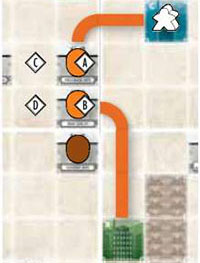
In this illustration, Orange has built complete links from the Commerce to the northern Parcel A, and from the Residence to the central Parcel B. As it is right now, the Passenger on the Commerce cannot travel to the Residence, because Parcel A and Parcel B are not connected (they are adjacent, but not connected).
In order to transport the Passenger, Orange would first need to either build a straight Rail through his Parcel A to connect to B, or a curved Rail through his Parcel B to connect to A, or both to connect the two existing links together into a single link.
The first two options would earn Orange 2 HP, but the third option would only earn Orange 1 HP for moving the Passenger. There is a fourth option, which would earn Orange 3 HP: Build 2 curved Rails in C and D to connect A to B!
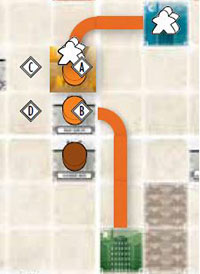
In this illustration, Orange has now built an Industry on Parcel A. Just like before, A is not connected to B, but now his options to connect them are more limited, because he can no longer build Rail through A.
He could still build a curved Rail in B to connect to the existing line to the Residence, which would make moving the Passenger to the Residence worth 2 HP; alternatively, he could build curved Rails in C and D to connect the Industry to Parcel B, which would make the same Passenger move worth 3 HP.
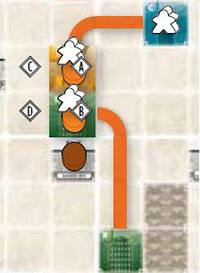
Now Orange has built a Residence on Parcel B, but the Commerce is still not connected to either Residence, and the only way remaining to do that is to build curved Rails in C and D to connect the Industry to the new Residence.
Even once he builds that new Rail link, he will not be able to deliver the Commerce Passenger to the original southern Residence, because the Passenger will stop at the first Residence, instead.
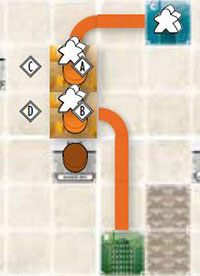
Another interesting option Orange had was to build an Industry on Parcel B, instead.
Now these two Industry tiles form one larger Industry, and the Commerce is connected to the large Industry, which is connected to the Residence.
From building the Industry tile, there's a Passenger at B, now, as well. This Passenger can leave via any rail connected to the large Industry, so the Passenger would already be able to travel to the Commerce or the Residence!
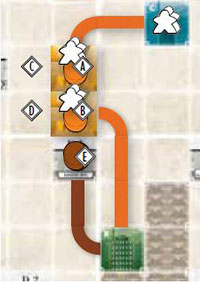
Later, Brown built a link from the Residence to his Parcel E. Brown wants to move the Passenger at B to the Residence, but he currently cannot do so on his own link.
He could build a straight Rail in E to connect to the large Industry.
He could build a Commerce, Residence, or Leisure Building in E, but it would not be connected to the Industry, without building another link between them.
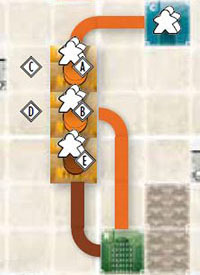
But if he builds an Industry tile in E, he enlarges the 2-space Industry into a 3-space Industry, all three links are now available for all three Passengers on it, and the Commerce, the Industry, and the Residence are all connected.
More importantly, Brown can now move that Passenger at B (or A , or E ) to the Residence along his Brown link.
Lateral thinking can really pay off in Alban Viard games!
Continue Reading
